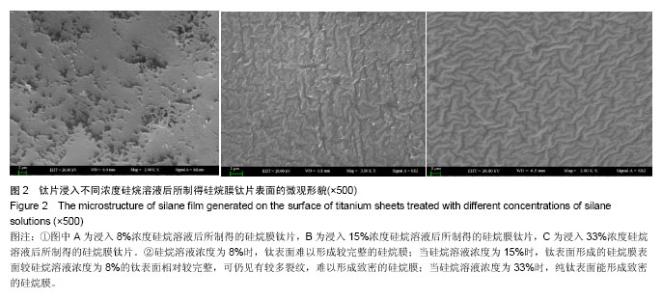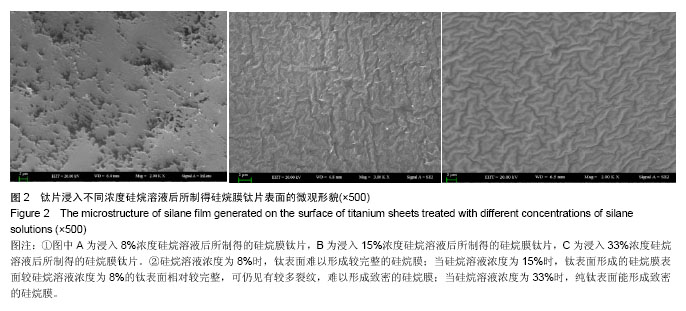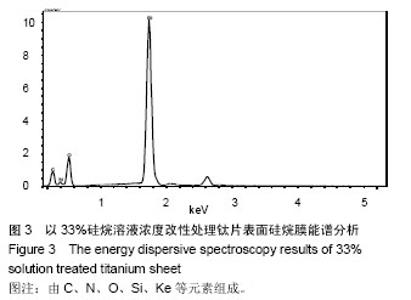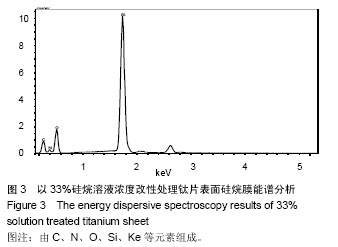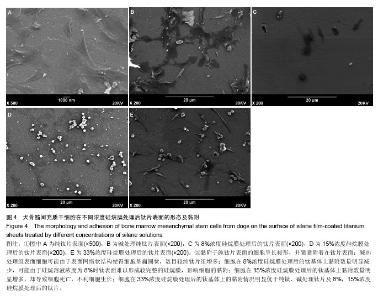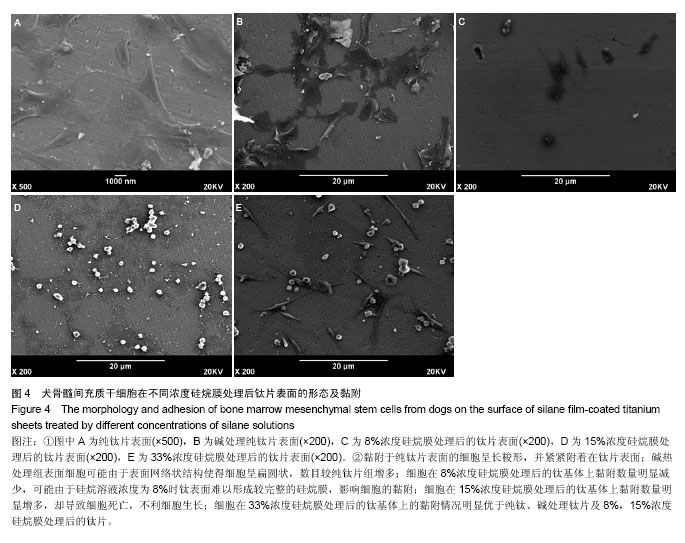| [1] 栗兴超,董福生.种植体表面优化处理对其骨结合促进的研究进展[J].现代口腔医学杂志,2007,21(6):645-646.
[2] 李争显,王少鹏,慕伟意,等.钛表面处理技术的研究现状[J].中国材料进展,2011,30(8):54-60.
[3] Leyens C,Peters M.Titanium and Titanium Alloy.Translated by Chen Zhenhua.Beijing:Chemical Industry Press,2005.
[4] 吴倩雯,郑元俐,黄慧.钛种植体表面生物化学改性的研究进展[J].口腔颌面修复学杂志, 2009,10(2):116-118.
[5] 谢加兵,徐祝军.钛植入材料表面生物化改性研究进展[J].国际骨科学杂志,2012,33(1):52-54.
[6] 孙振,王东.种植体表面改性的现状和发展[J].现代口腔医学杂志,2010,24(2):152-153.
[7] Cecchetto L,Denoyelle A,Delabouglise D,et al.A silane pre-treatment for improving corrosion resistance performances of emeraldine base-coated aluminium samples in neutral environment.Appl Surf Sci. 2008;254(15): 1736-1743.
[8] Dettin M,Herath T,Gambaretto R,et al.Assessment of novel chemical strategies for covalent attachment of adhesive peptides to rough titanium surfaces:XPS analysis and biological enaluation.J Biomed Mater Res A. 2009;91(2): 463-479.
[9] 宁成云,刘绪建.硅烷偶联剂对纯钛表面改性的研究[J].稀有金属材料与工程,2009,38(11):2017-2019.
[10] 曾晶晶,周诺,黄旋平,等.犬骨髓间质干细胞体外培养和鉴定[J].实用医学杂志,2013,29(16):2649-2651.
[11] 曹浩,葛建军,吴胜东,等.犬骨髓间充质干细胞的分离纯化与体外培养方法的探讨[J].安徽医科大学学报,2006,41(6):704-706.
[12] 谢永林,陈一,孙勇.钛及钛合金种植体表面涂层处理的研究进展[J].川北医学院学报,2011,26(1):82.
[13] Puleo DA,Thomas MV.Implant surfaces.Dent Clin North Am. 2006;50(3):323-338.
[14] 陈卓凡.口腔种植治疗的基础研究与临床应用[M].北京:人民军医出版社,2010:11.
[15] 梁峥嵘,韩栋伟.纯钛表面改性对细菌粘附的影响[J].临床口腔医学杂志,2009,25(10):590-592.
[16] 白薇.纯钛材料表面离子束改性的研究[D].四川大学博士学位论文,2002.
[17] 杨云志.人体硬组织生物梯度材料的研究[D].华西医科大学博士后工作报告,1999.
[18] Anselme K.Osteoblast adhesion on biomaterials.Biomaterials. 2000;21(7):667-681.
[19] Werner S,Huck O,Frisch B,et al.The effect of microstructured surfaces and laminin-derived peptide coatings on soft tissue interactions with titanium dental implants.Bionmaterials.2009; 30(12):2291-2321.
[20] 贾彦,邓嘉胤.钛种植体表面改性的研究现状及应用进展[J].中国组织工程研究与临床康复,2009,13(12):2321-2324.
[21] 杨征,黄承敏,巢永烈.等离子浸没注入对纯钛及钛合金表面耐腐蚀性能影响的研究[J].华西医学,2008,23(3):473-474.
[22] Park JW,Jang JH,Lee CS,et al.Osteoconductivity of hydrophilic microstructured titanium implants with phosphate ion chemistry.Acta Biomater.2009;5(6):2311-2321.
[23] 郑军.HA/TCP 复合BMP及bFGF在体内成骨能力及对骨缺损修复的实验研究[D].东南大学,2005.
[24] 黄辉,马轩祥,付涛,等.生物材料表面固定粘附肽调节小鼠成骨细胞骨钙素的表达[J].实用口腔医学,2001,17(2):86-88.
[25] Morra M.Biochemical modification of titanium surfaces: peptides and ECM proteins. Eur Cell Mater.2006;12:1-15.
[26] 王雪明,李爱菊,李国丽,等.硅烷偶联剂在防腐涂层金属预处理中的应用研究[J].材料科学与工程学报,2005,23(1):146-150.
[27] 温建萍,甄明辉,沈洲.偶联修饰纳米蒙脱土/超高分子量聚乙烯基复合材料的摩擦磨损性能[J].硅酸盐学报,2007,35(8): 1040-1045.
[28] Xie GZ,Wang P,Yuan LK,et al.The effect of coupling agent on the microwave properties of the melt-spun iron/earth nanocomposites.J Appl Polym Sci.2009;114(4):2344-2347.
[29] 许育东,陈云帮,石敏,等.金属表面硅烷化处理应用的研究[J].金属功能材料,2011,18(5):65-69.
[30] 李志安.钛种植体表面改性的现状、问题与发展趋势[J].口腔材料器械杂志,2013,22(2):57-58.
[31] Fang M,Chai F,Chen JH,et al.Antibacterial functionalization of an experimental self-etching primer by inorganic agents: microbiological and biocompatibility evaluations.Biomol Eng. 2007;24(5):483-488.
[32] Guerrero G,Amalric J,Mutin PH,et al.Inhibition of bacterial adhesion and prevention of biofilm formation: Use of organic self-assembled monolayers on inorganic surfaces.Pathol Biol (Paris).2009;57(1):36-43.
[33] Kitasako Y,Senpuku H,Foxton RM,et al.Growth-inhibitory effect of antibacterial self-etching primer on mutans streptococci obtained from arrested carious lesions.J Esthet Restor Dent. 2004;16(3):176-182; discussion 183-184.
[34] Gondim JO,Duque C,Hebling J,et al.Influence of human dentine on the antibacterial activity of self-etching adhesive systems against cariogenic bacteria.J Dent. 2008;36(4) 241-248.
[35] Imazato S,Imai T,Russell RR,et al.Antibacterial activity of cured dental resin incorporating the antibacterial monomer MDPB and an adhesion-promoting monomer.J Biomed Mater Res.1998;39(4):511-515.
[36] Hiraishi N,Yiu CK,King NM,et al.Chlorhexidine release and antibacterial properties of chlorhexidine-incorporated polymethyl methacrylate-based resin cement.J Biomed Mater Res B Appl Biomater.2010;94(1):134-140. |
